Exploring Cultural Diversity in Organizational Management at Amazon UK
VerifiedAdded on 2023/06/18
|24
|8437
|383
Report
AI Summary
This report proposal investigates the impact of cultural diversity on organizational management, focusing on a case study of Amazon warehouses in the UK. It aims to evaluate how a diverse workforce influences management activities and organizational culture. The research objectives include determining the extent to which a multicultural workforce changes organizational culture, identifying effective management strategies for cross-cultural workforces, and exploring tools and processes to minimize negative impacts and maximize integration. The literature review covers organizational culture, workforce diversity, and intra-group conflict, drawing on various theories and studies. The methodology outlines a research paradigm, data collection tools, ethical considerations, and data analysis techniques. The study acknowledges limitations and provides a framework for understanding and managing cultural diversity within organizations.
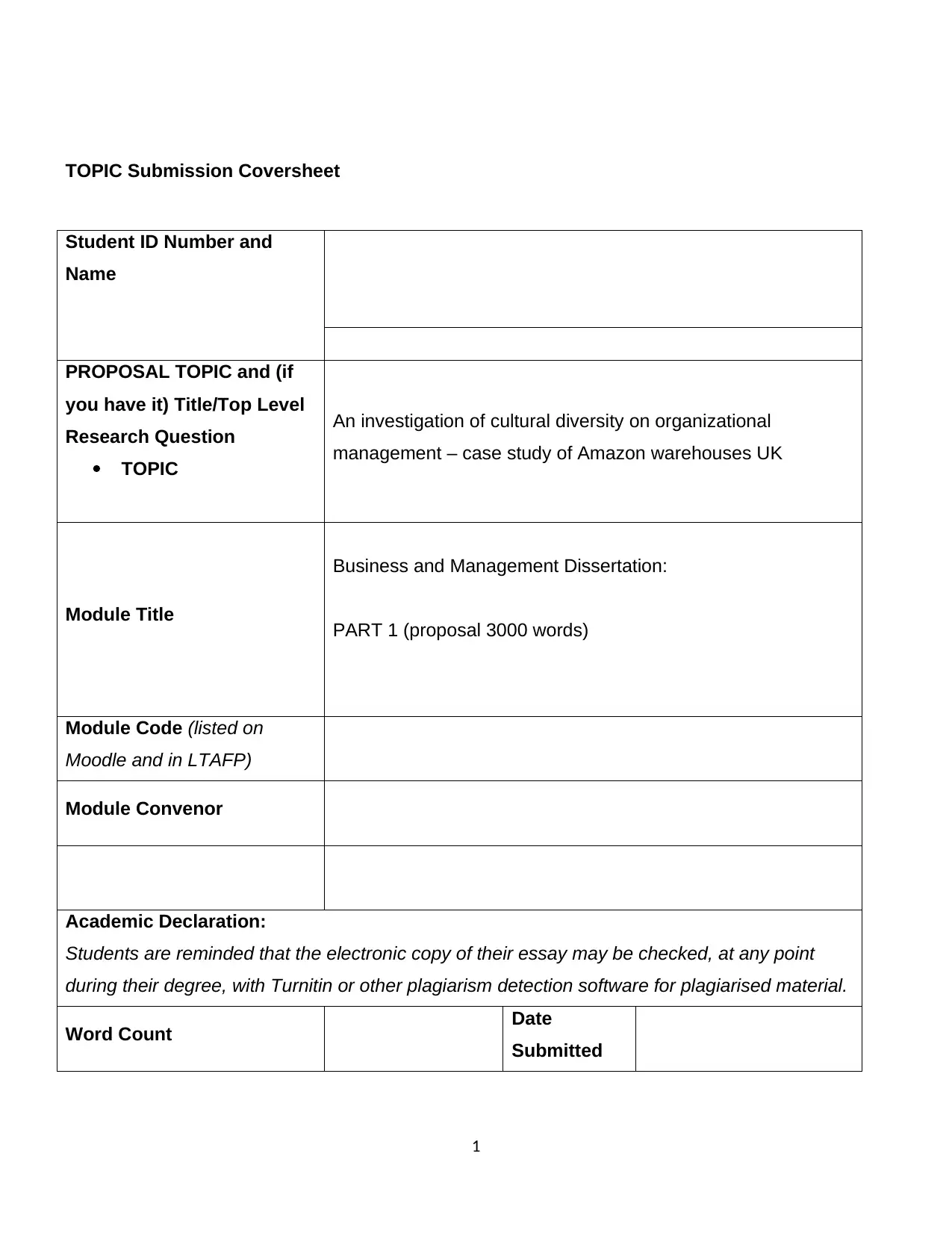
TOPIC Submission Coversheet
Student ID Number and
Name
PROPOSAL TOPIC and (if
you have it) Title/Top Level
Research Question
TOPIC
An investigation of cultural diversity on organizational
management – case study of Amazon warehouses UK
Module Title
Business and Management Dissertation:
PART 1 (proposal 3000 words)
Module Code (listed on
Moodle and in LTAFP)
Module Convenor
Academic Declaration:
Students are reminded that the electronic copy of their essay may be checked, at any point
during their degree, with Turnitin or other plagiarism detection software for plagiarised material.
Word Count Date
Submitted
1
Student ID Number and
Name
PROPOSAL TOPIC and (if
you have it) Title/Top Level
Research Question
TOPIC
An investigation of cultural diversity on organizational
management – case study of Amazon warehouses UK
Module Title
Business and Management Dissertation:
PART 1 (proposal 3000 words)
Module Code (listed on
Moodle and in LTAFP)
Module Convenor
Academic Declaration:
Students are reminded that the electronic copy of their essay may be checked, at any point
during their degree, with Turnitin or other plagiarism detection software for plagiarised material.
Word Count Date
Submitted
1
Paraphrase This Document
Need a fresh take? Get an instant paraphrase of this document with our AI Paraphraser
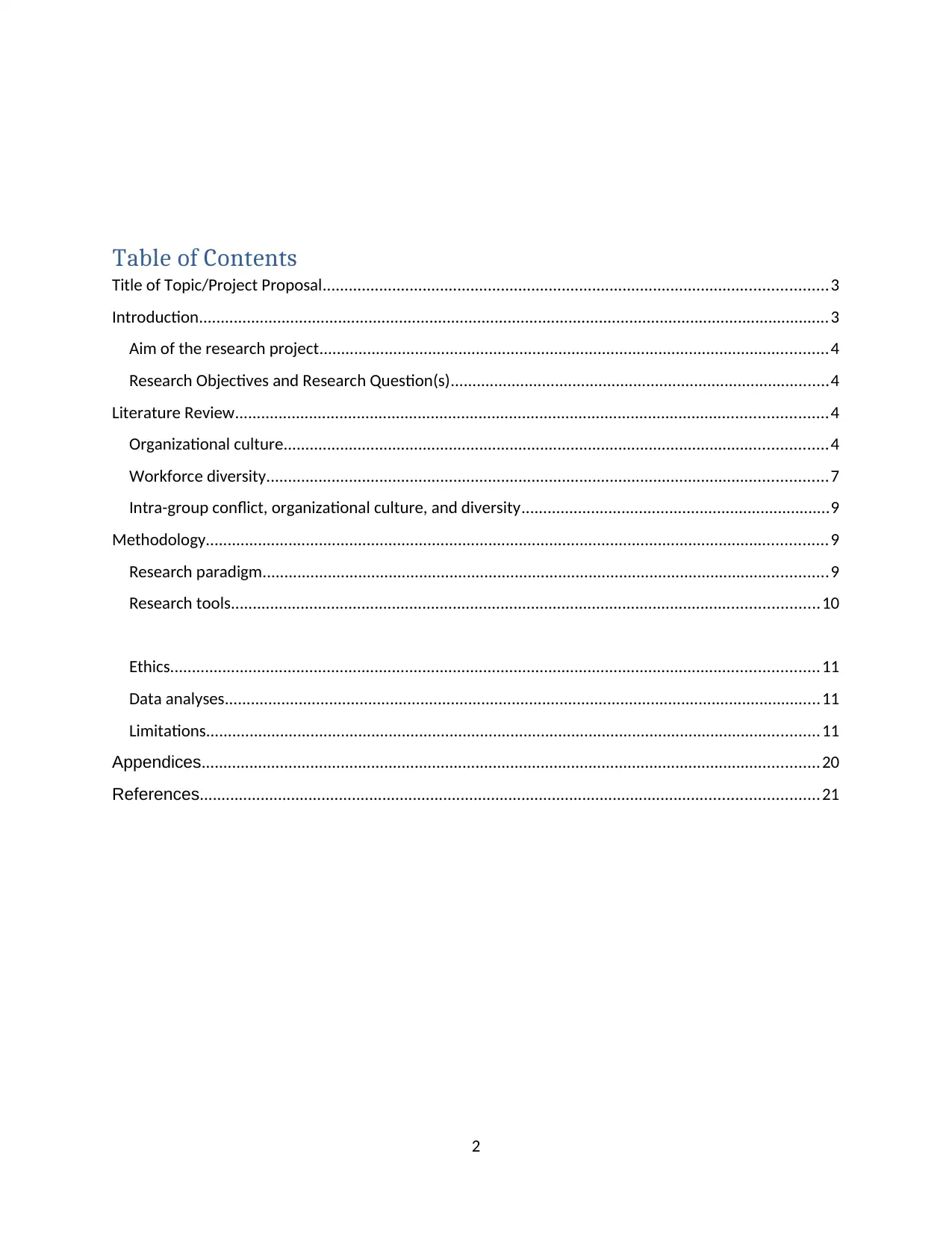
Table of Contents
Title of Topic/Project Proposal....................................................................................................................3
Introduction.................................................................................................................................................3
Aim of the research project.....................................................................................................................4
Research Objectives and Research Question(s).......................................................................................4
Literature Review........................................................................................................................................4
Organizational culture.............................................................................................................................4
Workforce diversity.................................................................................................................................7
Intra-group conflict, organizational culture, and diversity.......................................................................9
Methodology...............................................................................................................................................9
Research paradigm..................................................................................................................................9
Research tools.......................................................................................................................................10
Ethics.....................................................................................................................................................11
Data analyses.........................................................................................................................................11
Limitations.............................................................................................................................................11
Appendices..............................................................................................................................................20
References..............................................................................................................................................21
2
Title of Topic/Project Proposal....................................................................................................................3
Introduction.................................................................................................................................................3
Aim of the research project.....................................................................................................................4
Research Objectives and Research Question(s).......................................................................................4
Literature Review........................................................................................................................................4
Organizational culture.............................................................................................................................4
Workforce diversity.................................................................................................................................7
Intra-group conflict, organizational culture, and diversity.......................................................................9
Methodology...............................................................................................................................................9
Research paradigm..................................................................................................................................9
Research tools.......................................................................................................................................10
Ethics.....................................................................................................................................................11
Data analyses.........................................................................................................................................11
Limitations.............................................................................................................................................11
Appendices..............................................................................................................................................20
References..............................................................................................................................................21
2
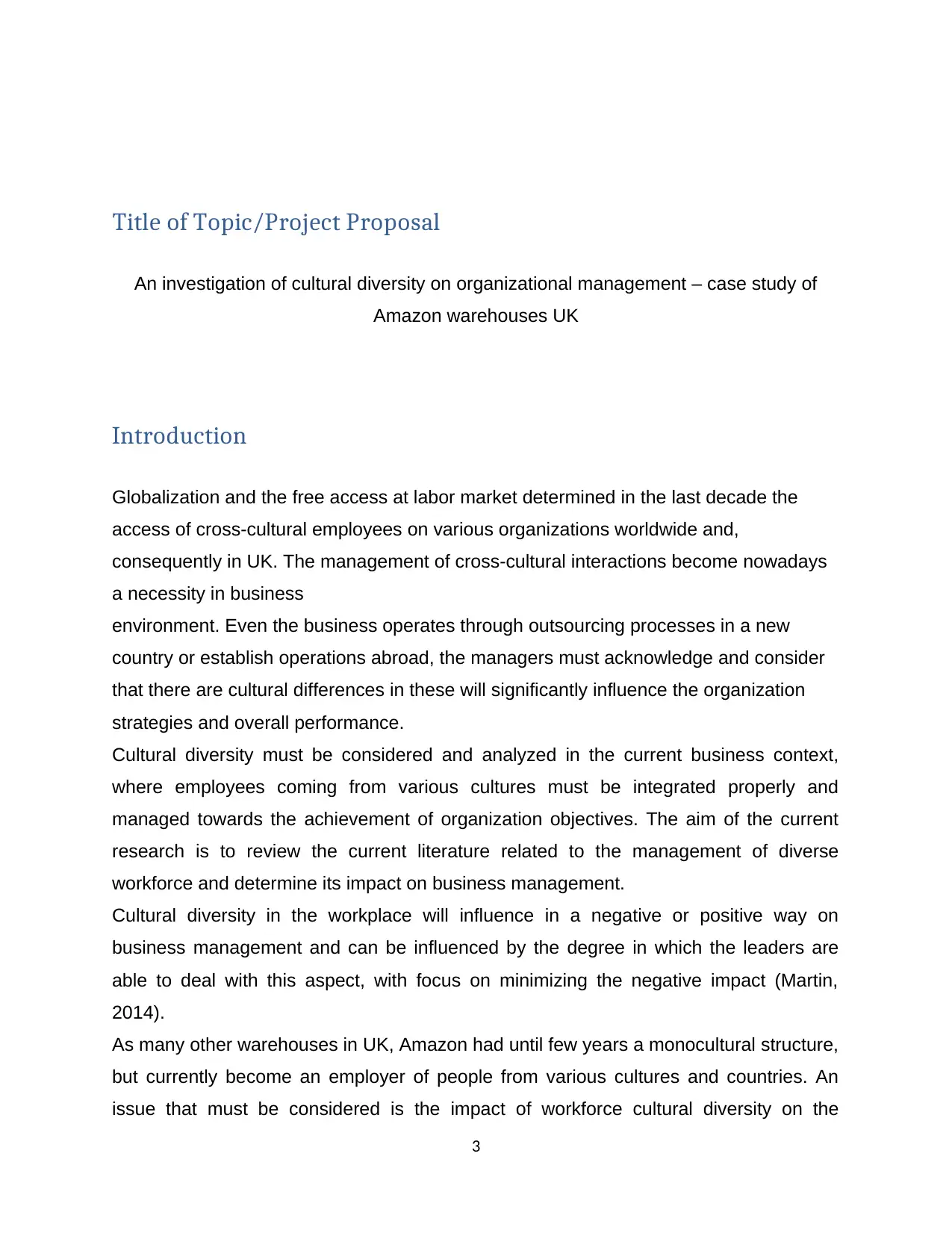
Title of Topic/Project Proposal
An investigation of cultural diversity on organizational management – case study of
Amazon warehouses UK
Introduction
Globalization and the free access at labor market determined in the last decade the
access of cross-cultural employees on various organizations worldwide and,
consequently in UK. The management of cross-cultural interactions become nowadays
a necessity in business
environment. Even the business operates through outsourcing processes in a new
country or establish operations abroad, the managers must acknowledge and consider
that there are cultural differences in these will significantly influence the organization
strategies and overall performance.
Cultural diversity must be considered and analyzed in the current business context,
where employees coming from various cultures must be integrated properly and
managed towards the achievement of organization objectives. The aim of the current
research is to review the current literature related to the management of diverse
workforce and determine its impact on business management.
Cultural diversity in the workplace will influence in a negative or positive way on
business management and can be influenced by the degree in which the leaders are
able to deal with this aspect, with focus on minimizing the negative impact (Martin,
2014).
As many other warehouses in UK, Amazon had until few years a monocultural structure,
but currently become an employer of people from various cultures and countries. An
issue that must be considered is the impact of workforce cultural diversity on the
3
An investigation of cultural diversity on organizational management – case study of
Amazon warehouses UK
Introduction
Globalization and the free access at labor market determined in the last decade the
access of cross-cultural employees on various organizations worldwide and,
consequently in UK. The management of cross-cultural interactions become nowadays
a necessity in business
environment. Even the business operates through outsourcing processes in a new
country or establish operations abroad, the managers must acknowledge and consider
that there are cultural differences in these will significantly influence the organization
strategies and overall performance.
Cultural diversity must be considered and analyzed in the current business context,
where employees coming from various cultures must be integrated properly and
managed towards the achievement of organization objectives. The aim of the current
research is to review the current literature related to the management of diverse
workforce and determine its impact on business management.
Cultural diversity in the workplace will influence in a negative or positive way on
business management and can be influenced by the degree in which the leaders are
able to deal with this aspect, with focus on minimizing the negative impact (Martin,
2014).
As many other warehouses in UK, Amazon had until few years a monocultural structure,
but currently become an employer of people from various cultures and countries. An
issue that must be considered is the impact of workforce cultural diversity on the
3
⊘ This is a preview!⊘
Do you want full access?
Subscribe today to unlock all pages.

Trusted by 1+ million students worldwide
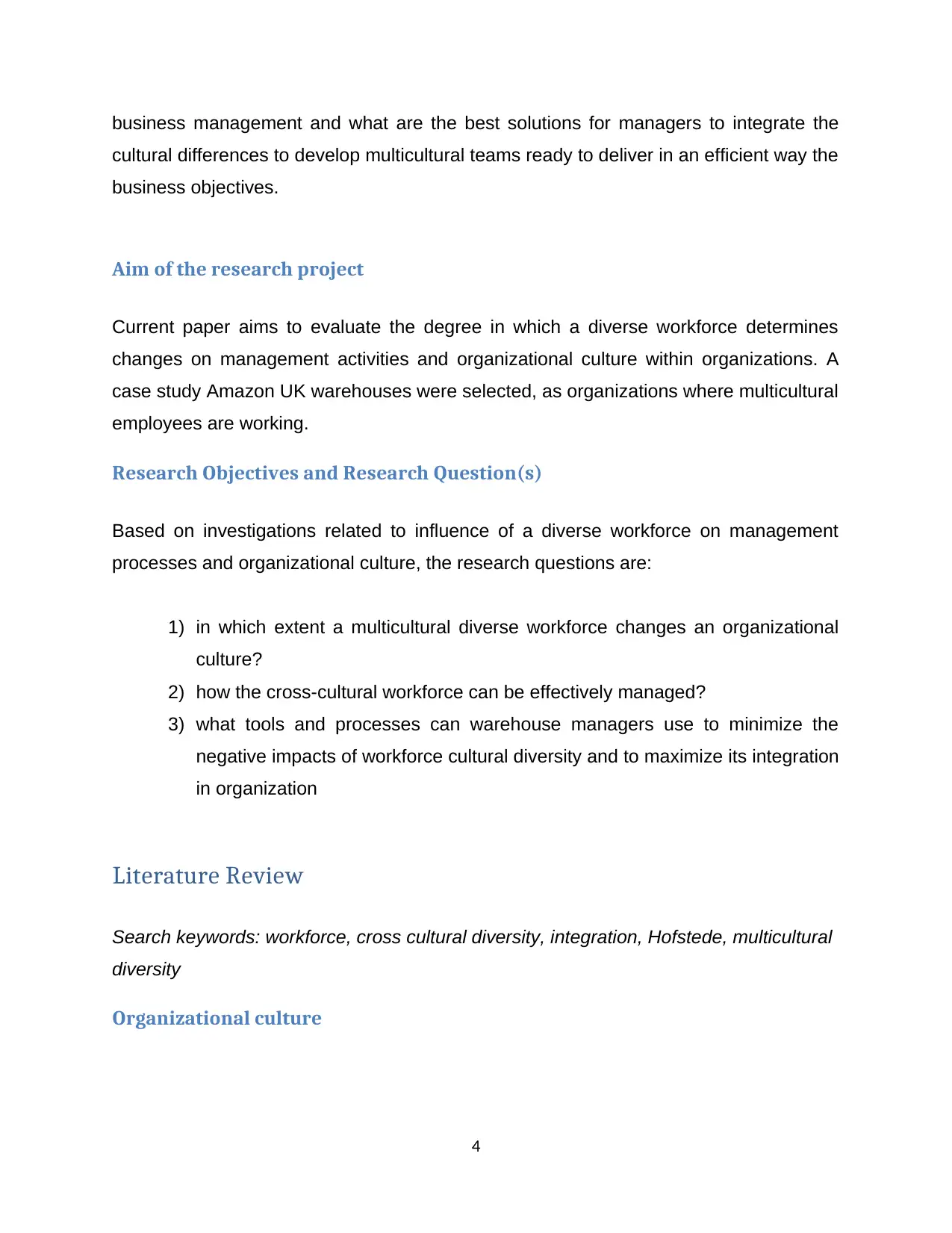
business management and what are the best solutions for managers to integrate the
cultural differences to develop multicultural teams ready to deliver in an efficient way the
business objectives.
Aim of the research project
Current paper aims to evaluate the degree in which a diverse workforce determines
changes on management activities and organizational culture within organizations. A
case study Amazon UK warehouses were selected, as organizations where multicultural
employees are working.
Research Objectives and Research Question(s)
Based on investigations related to influence of a diverse workforce on management
processes and organizational culture, the research questions are:
1) in which extent a multicultural diverse workforce changes an organizational
culture?
2) how the cross-cultural workforce can be effectively managed?
3) what tools and processes can warehouse managers use to minimize the
negative impacts of workforce cultural diversity and to maximize its integration
in organization
Literature Review
Search keywords: workforce, cross cultural diversity, integration, Hofstede, multicultural
diversity
Organizational culture
4
cultural differences to develop multicultural teams ready to deliver in an efficient way the
business objectives.
Aim of the research project
Current paper aims to evaluate the degree in which a diverse workforce determines
changes on management activities and organizational culture within organizations. A
case study Amazon UK warehouses were selected, as organizations where multicultural
employees are working.
Research Objectives and Research Question(s)
Based on investigations related to influence of a diverse workforce on management
processes and organizational culture, the research questions are:
1) in which extent a multicultural diverse workforce changes an organizational
culture?
2) how the cross-cultural workforce can be effectively managed?
3) what tools and processes can warehouse managers use to minimize the
negative impacts of workforce cultural diversity and to maximize its integration
in organization
Literature Review
Search keywords: workforce, cross cultural diversity, integration, Hofstede, multicultural
diversity
Organizational culture
4
Paraphrase This Document
Need a fresh take? Get an instant paraphrase of this document with our AI Paraphraser

Culture is considered nowadays an important and integral constituent in the
organizational research (Kartolo and Kwantes, 2018). Even there are multiple definitions
of the organizational culture in the literature, a general viewpoint can be identified,
outlining that organizational culture reveal and is influenced by values, attitudes,
expectations commonly possessed by the members of the organization, being
approached as unconscious basic assumptions of the organization associates(Schein,
2004). These basic assumptions are visible through shared behaviours and artifacts
(Brettel et. al., 2015).
Hofstede (1991) defined culture as “the collective programming of the human mind that
distinguishes the members of one human group from those of another, adding that a
culture can be understand as a system of valued held in a collective way.
Organizational culture similarity has been identified as being associated in a positive
manner with the organization performance (Schein, 1995).
Organizational culture has a dual influence, at organizational and employee level, being
seen as a power that keeps organizations together (Goffee and Jones, 1996), aspect
that holds a significant importance in the success or breakdown of a certain
organization in different business areas, including the implementation of its strategy
(Vaara et. al., 2010), organizational development and in the processes linked with
mergers and acquisitions (Weber, 1996). Organizational culture impact on employee’s
performance is visible in job performance and the intention to remain within the
organization (staff loyalty or turnover intention) (Murphy et. al., 2013). According to
Cooke and Szumal (1993) the organizational culture reveals two important constituents:
the shared expectations from behavioural perspective and the normative beliefs.
Normative beliefs are linked with the individual beliefs and knowledge in relationship
with what is expected from the members of a certain group or organization (Fishbein,
1972), while the shared behavioural expectations are determined by the normative
beliefs and defines the set of expected and shared behaviours from the members of a
certain group or organization (Cooke and Szumal, 1993). The behavioural norms
mention the expected way in which the group members are expected to deal with their
5
organizational research (Kartolo and Kwantes, 2018). Even there are multiple definitions
of the organizational culture in the literature, a general viewpoint can be identified,
outlining that organizational culture reveal and is influenced by values, attitudes,
expectations commonly possessed by the members of the organization, being
approached as unconscious basic assumptions of the organization associates(Schein,
2004). These basic assumptions are visible through shared behaviours and artifacts
(Brettel et. al., 2015).
Hofstede (1991) defined culture as “the collective programming of the human mind that
distinguishes the members of one human group from those of another, adding that a
culture can be understand as a system of valued held in a collective way.
Organizational culture similarity has been identified as being associated in a positive
manner with the organization performance (Schein, 1995).
Organizational culture has a dual influence, at organizational and employee level, being
seen as a power that keeps organizations together (Goffee and Jones, 1996), aspect
that holds a significant importance in the success or breakdown of a certain
organization in different business areas, including the implementation of its strategy
(Vaara et. al., 2010), organizational development and in the processes linked with
mergers and acquisitions (Weber, 1996). Organizational culture impact on employee’s
performance is visible in job performance and the intention to remain within the
organization (staff loyalty or turnover intention) (Murphy et. al., 2013). According to
Cooke and Szumal (1993) the organizational culture reveals two important constituents:
the shared expectations from behavioural perspective and the normative beliefs.
Normative beliefs are linked with the individual beliefs and knowledge in relationship
with what is expected from the members of a certain group or organization (Fishbein,
1972), while the shared behavioural expectations are determined by the normative
beliefs and defines the set of expected and shared behaviours from the members of a
certain group or organization (Cooke and Szumal, 1993). The behavioural norms
mention the expected way in which the group members are expected to deal with their
5
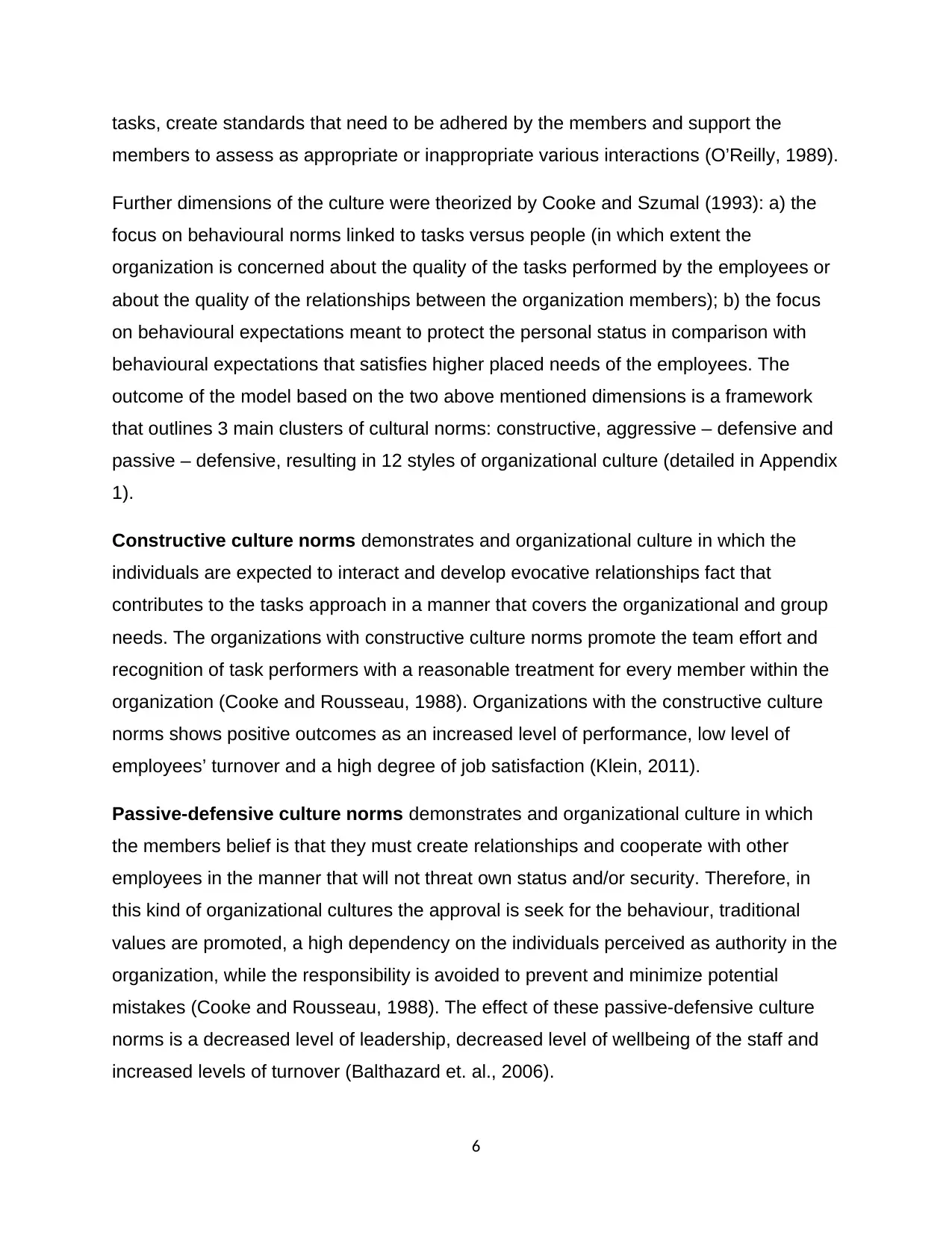
tasks, create standards that need to be adhered by the members and support the
members to assess as appropriate or inappropriate various interactions (O’Reilly, 1989).
Further dimensions of the culture were theorized by Cooke and Szumal (1993): a) the
focus on behavioural norms linked to tasks versus people (in which extent the
organization is concerned about the quality of the tasks performed by the employees or
about the quality of the relationships between the organization members); b) the focus
on behavioural expectations meant to protect the personal status in comparison with
behavioural expectations that satisfies higher placed needs of the employees. The
outcome of the model based on the two above mentioned dimensions is a framework
that outlines 3 main clusters of cultural norms: constructive, aggressive – defensive and
passive – defensive, resulting in 12 styles of organizational culture (detailed in Appendix
1).
Constructive culture norms demonstrates and organizational culture in which the
individuals are expected to interact and develop evocative relationships fact that
contributes to the tasks approach in a manner that covers the organizational and group
needs. The organizations with constructive culture norms promote the team effort and
recognition of task performers with a reasonable treatment for every member within the
organization (Cooke and Rousseau, 1988). Organizations with the constructive culture
norms shows positive outcomes as an increased level of performance, low level of
employees’ turnover and a high degree of job satisfaction (Klein, 2011).
Passive-defensive culture norms demonstrates and organizational culture in which
the members belief is that they must create relationships and cooperate with other
employees in the manner that will not threat own status and/or security. Therefore, in
this kind of organizational cultures the approval is seek for the behaviour, traditional
values are promoted, a high dependency on the individuals perceived as authority in the
organization, while the responsibility is avoided to prevent and minimize potential
mistakes (Cooke and Rousseau, 1988). The effect of these passive-defensive culture
norms is a decreased level of leadership, decreased level of wellbeing of the staff and
increased levels of turnover (Balthazard et. al., 2006).
6
members to assess as appropriate or inappropriate various interactions (O’Reilly, 1989).
Further dimensions of the culture were theorized by Cooke and Szumal (1993): a) the
focus on behavioural norms linked to tasks versus people (in which extent the
organization is concerned about the quality of the tasks performed by the employees or
about the quality of the relationships between the organization members); b) the focus
on behavioural expectations meant to protect the personal status in comparison with
behavioural expectations that satisfies higher placed needs of the employees. The
outcome of the model based on the two above mentioned dimensions is a framework
that outlines 3 main clusters of cultural norms: constructive, aggressive – defensive and
passive – defensive, resulting in 12 styles of organizational culture (detailed in Appendix
1).
Constructive culture norms demonstrates and organizational culture in which the
individuals are expected to interact and develop evocative relationships fact that
contributes to the tasks approach in a manner that covers the organizational and group
needs. The organizations with constructive culture norms promote the team effort and
recognition of task performers with a reasonable treatment for every member within the
organization (Cooke and Rousseau, 1988). Organizations with the constructive culture
norms shows positive outcomes as an increased level of performance, low level of
employees’ turnover and a high degree of job satisfaction (Klein, 2011).
Passive-defensive culture norms demonstrates and organizational culture in which
the members belief is that they must create relationships and cooperate with other
employees in the manner that will not threat own status and/or security. Therefore, in
this kind of organizational cultures the approval is seek for the behaviour, traditional
values are promoted, a high dependency on the individuals perceived as authority in the
organization, while the responsibility is avoided to prevent and minimize potential
mistakes (Cooke and Rousseau, 1988). The effect of these passive-defensive culture
norms is a decreased level of leadership, decreased level of wellbeing of the staff and
increased levels of turnover (Balthazard et. al., 2006).
6
⊘ This is a preview!⊘
Do you want full access?
Subscribe today to unlock all pages.

Trusted by 1+ million students worldwide

Aggressive-defensive culture norms demonstrates and organizational culture in
which the members are concentrated on tasks and tackle them in ways that will ensure
the protection of own status and security. The organization members are encouraged to
do the allocated tasks at a minimum acceptable eroding the need of meaningful
interactions and relationships within the organization (Cooke and Rousseau, 1988). The
organizations with aggressive-defensive culture norms will notice a certain level of
performance but does not struggle for excellence in individual performance, with same
impact on organizational performance and low levels of innovation (Cooke and
Rousseau, 1988). The tasks are valued against relationships in this organizations,
therefore this workplace might be hostile for minorities (Steele, 1997).
Workforce diversity
Workforce structure has been transformed in an accelerated way in the last 3 decades
due to immigration increase and the globalization of organizations, trends that
determined an increased level of demographic diversity within companies (Chuang et.
al., 2004). Diversity includes various characteristics and experiences of an organization
workforce that influence in a positive or negative way the company performance. As
result, every organization must consider diversity as a significant point focus to create
competitive advantages on the market. Moreover, the management must consider the
value added by a working environment multicultural friendly, to promote an inclusive
workplace (Mazour, 2010). The existing research outline five main demographic
attributes that have impact on organizational management: age, gender, functional and
educational background, race, role in organization (Williams abd O’Reilly, 1998). The
impact and effects of these attributes are present in the literature, with various findings.
According to Lawrence (1997) organizations must pay attention not only to the
relationship between diversity and teams results but at the same time the teams
process variables. Current research focuses on the intragroup processes, in diversity
context as the addition of the previous research. Organizational culture is considered for
the investigation due to its contribution, as contextual factor, to the group processes
7
which the members are concentrated on tasks and tackle them in ways that will ensure
the protection of own status and security. The organization members are encouraged to
do the allocated tasks at a minimum acceptable eroding the need of meaningful
interactions and relationships within the organization (Cooke and Rousseau, 1988). The
organizations with aggressive-defensive culture norms will notice a certain level of
performance but does not struggle for excellence in individual performance, with same
impact on organizational performance and low levels of innovation (Cooke and
Rousseau, 1988). The tasks are valued against relationships in this organizations,
therefore this workplace might be hostile for minorities (Steele, 1997).
Workforce diversity
Workforce structure has been transformed in an accelerated way in the last 3 decades
due to immigration increase and the globalization of organizations, trends that
determined an increased level of demographic diversity within companies (Chuang et.
al., 2004). Diversity includes various characteristics and experiences of an organization
workforce that influence in a positive or negative way the company performance. As
result, every organization must consider diversity as a significant point focus to create
competitive advantages on the market. Moreover, the management must consider the
value added by a working environment multicultural friendly, to promote an inclusive
workplace (Mazour, 2010). The existing research outline five main demographic
attributes that have impact on organizational management: age, gender, functional and
educational background, race, role in organization (Williams abd O’Reilly, 1998). The
impact and effects of these attributes are present in the literature, with various findings.
According to Lawrence (1997) organizations must pay attention not only to the
relationship between diversity and teams results but at the same time the teams
process variables. Current research focuses on the intragroup processes, in diversity
context as the addition of the previous research. Organizational culture is considered for
the investigation due to its contribution, as contextual factor, to the group processes
7
Paraphrase This Document
Need a fresh take? Get an instant paraphrase of this document with our AI Paraphraser
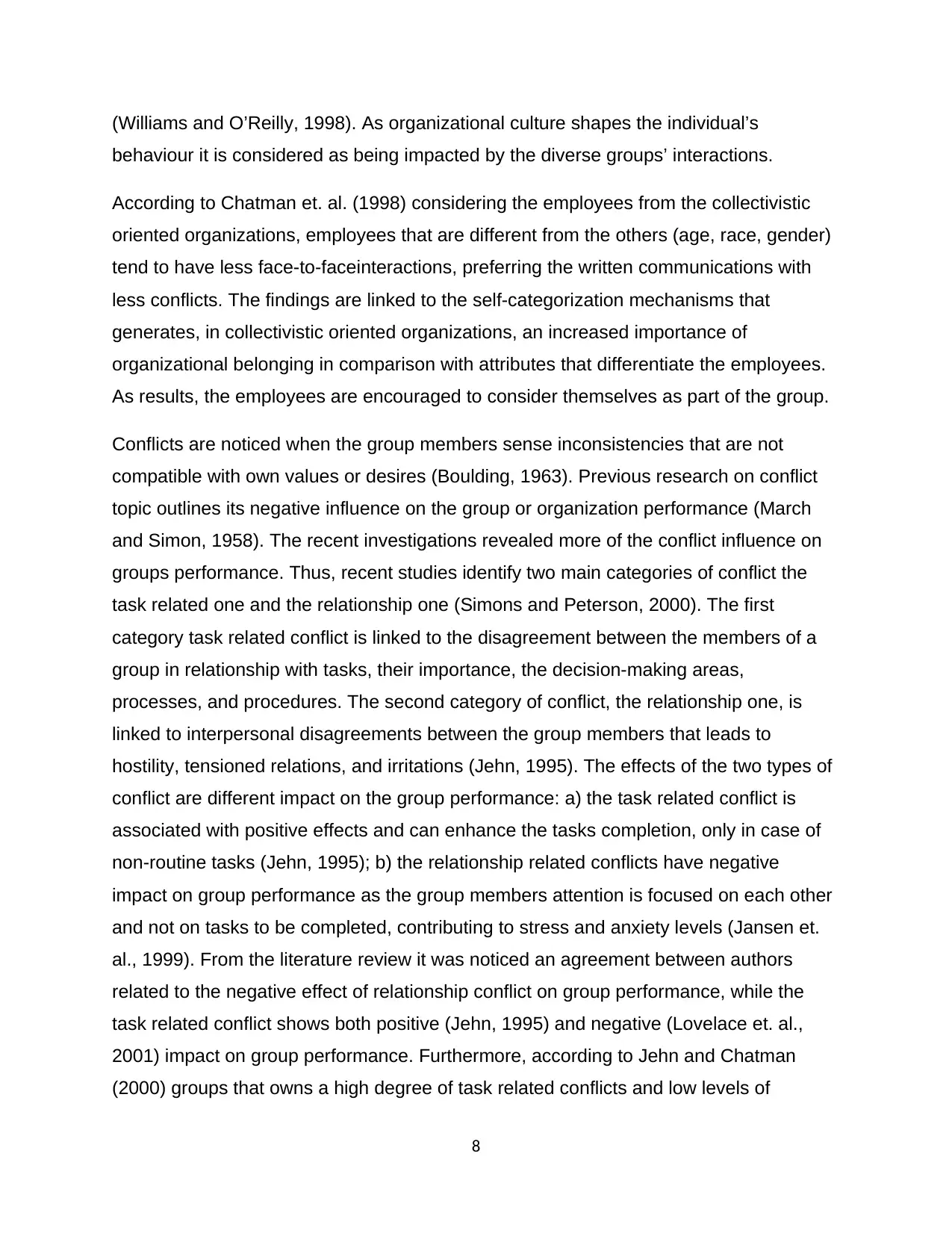
(Williams and O’Reilly, 1998). As organizational culture shapes the individual’s
behaviour it is considered as being impacted by the diverse groups’ interactions.
According to Chatman et. al. (1998) considering the employees from the collectivistic
oriented organizations, employees that are different from the others (age, race, gender)
tend to have less face-to-faceinteractions, preferring the written communications with
less conflicts. The findings are linked to the self-categorization mechanisms that
generates, in collectivistic oriented organizations, an increased importance of
organizational belonging in comparison with attributes that differentiate the employees.
As results, the employees are encouraged to consider themselves as part of the group.
Conflicts are noticed when the group members sense inconsistencies that are not
compatible with own values or desires (Boulding, 1963). Previous research on conflict
topic outlines its negative influence on the group or organization performance (March
and Simon, 1958). The recent investigations revealed more of the conflict influence on
groups performance. Thus, recent studies identify two main categories of conflict the
task related one and the relationship one (Simons and Peterson, 2000). The first
category task related conflict is linked to the disagreement between the members of a
group in relationship with tasks, their importance, the decision-making areas,
processes, and procedures. The second category of conflict, the relationship one, is
linked to interpersonal disagreements between the group members that leads to
hostility, tensioned relations, and irritations (Jehn, 1995). The effects of the two types of
conflict are different impact on the group performance: a) the task related conflict is
associated with positive effects and can enhance the tasks completion, only in case of
non-routine tasks (Jehn, 1995); b) the relationship related conflicts have negative
impact on group performance as the group members attention is focused on each other
and not on tasks to be completed, contributing to stress and anxiety levels (Jansen et.
al., 1999). From the literature review it was noticed an agreement between authors
related to the negative effect of relationship conflict on group performance, while the
task related conflict shows both positive (Jehn, 1995) and negative (Lovelace et. al.,
2001) impact on group performance. Furthermore, according to Jehn and Chatman
(2000) groups that owns a high degree of task related conflicts and low levels of
8
behaviour it is considered as being impacted by the diverse groups’ interactions.
According to Chatman et. al. (1998) considering the employees from the collectivistic
oriented organizations, employees that are different from the others (age, race, gender)
tend to have less face-to-faceinteractions, preferring the written communications with
less conflicts. The findings are linked to the self-categorization mechanisms that
generates, in collectivistic oriented organizations, an increased importance of
organizational belonging in comparison with attributes that differentiate the employees.
As results, the employees are encouraged to consider themselves as part of the group.
Conflicts are noticed when the group members sense inconsistencies that are not
compatible with own values or desires (Boulding, 1963). Previous research on conflict
topic outlines its negative influence on the group or organization performance (March
and Simon, 1958). The recent investigations revealed more of the conflict influence on
groups performance. Thus, recent studies identify two main categories of conflict the
task related one and the relationship one (Simons and Peterson, 2000). The first
category task related conflict is linked to the disagreement between the members of a
group in relationship with tasks, their importance, the decision-making areas,
processes, and procedures. The second category of conflict, the relationship one, is
linked to interpersonal disagreements between the group members that leads to
hostility, tensioned relations, and irritations (Jehn, 1995). The effects of the two types of
conflict are different impact on the group performance: a) the task related conflict is
associated with positive effects and can enhance the tasks completion, only in case of
non-routine tasks (Jehn, 1995); b) the relationship related conflicts have negative
impact on group performance as the group members attention is focused on each other
and not on tasks to be completed, contributing to stress and anxiety levels (Jansen et.
al., 1999). From the literature review it was noticed an agreement between authors
related to the negative effect of relationship conflict on group performance, while the
task related conflict shows both positive (Jehn, 1995) and negative (Lovelace et. al.,
2001) impact on group performance. Furthermore, according to Jehn and Chatman
(2000) groups that owns a high degree of task related conflicts and low levels of
8
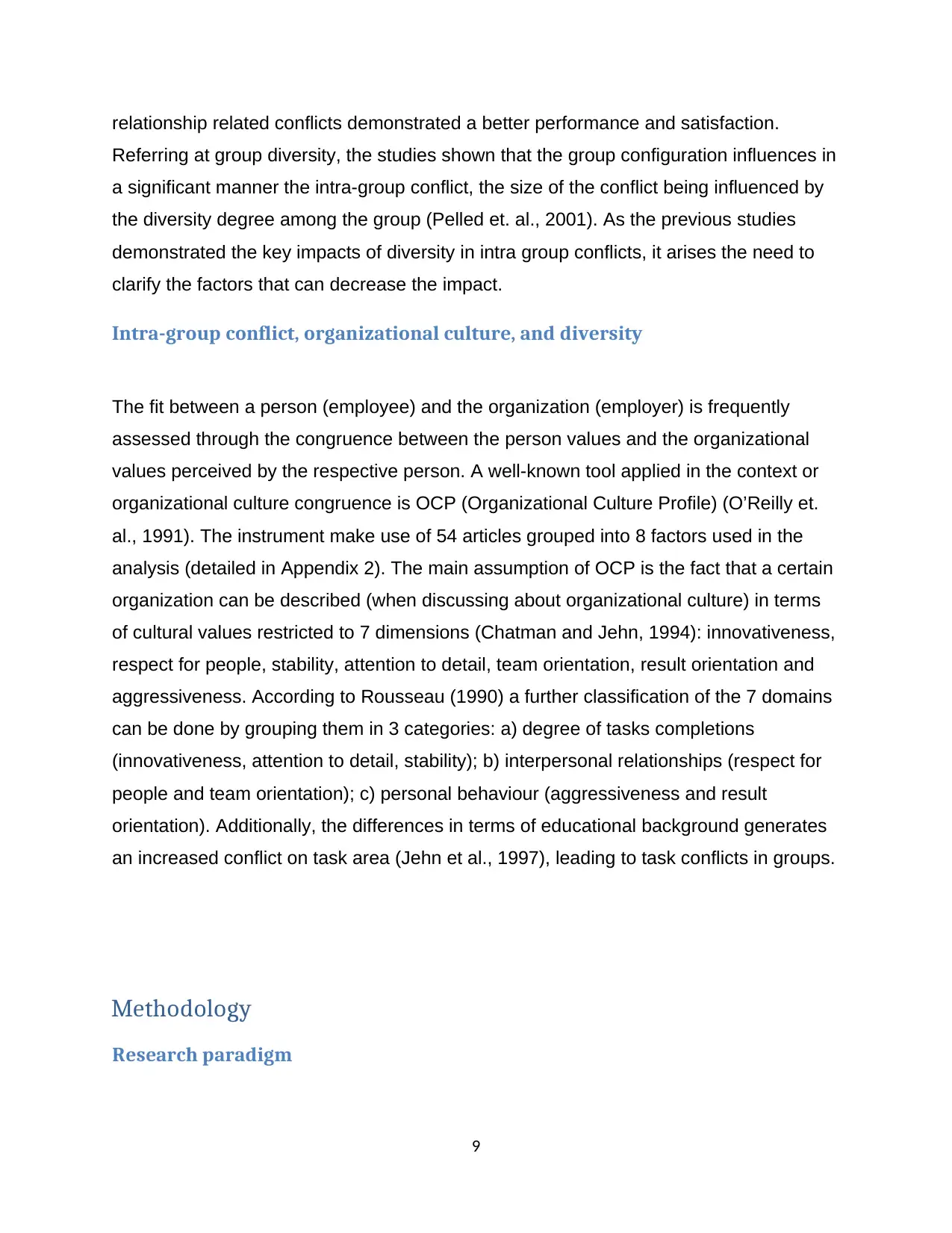
relationship related conflicts demonstrated a better performance and satisfaction.
Referring at group diversity, the studies shown that the group configuration influences in
a significant manner the intra-group conflict, the size of the conflict being influenced by
the diversity degree among the group (Pelled et. al., 2001). As the previous studies
demonstrated the key impacts of diversity in intra group conflicts, it arises the need to
clarify the factors that can decrease the impact.
Intra-group conflict, organizational culture, and diversity
The fit between a person (employee) and the organization (employer) is frequently
assessed through the congruence between the person values and the organizational
values perceived by the respective person. A well-known tool applied in the context or
organizational culture congruence is OCP (Organizational Culture Profile) (O’Reilly et.
al., 1991). The instrument make use of 54 articles grouped into 8 factors used in the
analysis (detailed in Appendix 2). The main assumption of OCP is the fact that a certain
organization can be described (when discussing about organizational culture) in terms
of cultural values restricted to 7 dimensions (Chatman and Jehn, 1994): innovativeness,
respect for people, stability, attention to detail, team orientation, result orientation and
aggressiveness. According to Rousseau (1990) a further classification of the 7 domains
can be done by grouping them in 3 categories: a) degree of tasks completions
(innovativeness, attention to detail, stability); b) interpersonal relationships (respect for
people and team orientation); c) personal behaviour (aggressiveness and result
orientation). Additionally, the differences in terms of educational background generates
an increased conflict on task area (Jehn et al., 1997), leading to task conflicts in groups.
Methodology
Research paradigm
9
Referring at group diversity, the studies shown that the group configuration influences in
a significant manner the intra-group conflict, the size of the conflict being influenced by
the diversity degree among the group (Pelled et. al., 2001). As the previous studies
demonstrated the key impacts of diversity in intra group conflicts, it arises the need to
clarify the factors that can decrease the impact.
Intra-group conflict, organizational culture, and diversity
The fit between a person (employee) and the organization (employer) is frequently
assessed through the congruence between the person values and the organizational
values perceived by the respective person. A well-known tool applied in the context or
organizational culture congruence is OCP (Organizational Culture Profile) (O’Reilly et.
al., 1991). The instrument make use of 54 articles grouped into 8 factors used in the
analysis (detailed in Appendix 2). The main assumption of OCP is the fact that a certain
organization can be described (when discussing about organizational culture) in terms
of cultural values restricted to 7 dimensions (Chatman and Jehn, 1994): innovativeness,
respect for people, stability, attention to detail, team orientation, result orientation and
aggressiveness. According to Rousseau (1990) a further classification of the 7 domains
can be done by grouping them in 3 categories: a) degree of tasks completions
(innovativeness, attention to detail, stability); b) interpersonal relationships (respect for
people and team orientation); c) personal behaviour (aggressiveness and result
orientation). Additionally, the differences in terms of educational background generates
an increased conflict on task area (Jehn et al., 1997), leading to task conflicts in groups.
Methodology
Research paradigm
9
⊘ This is a preview!⊘
Do you want full access?
Subscribe today to unlock all pages.

Trusted by 1+ million students worldwide
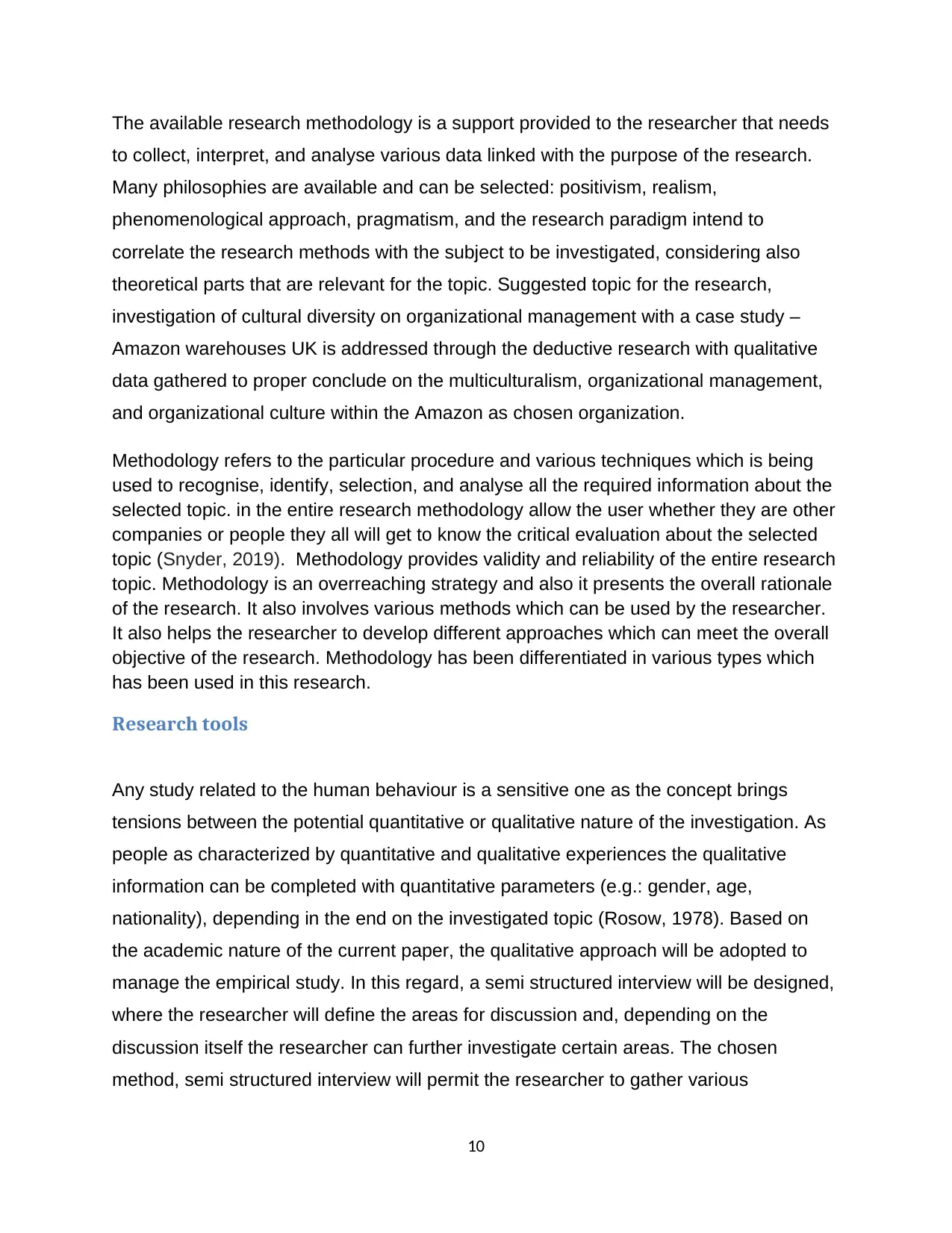
The available research methodology is a support provided to the researcher that needs
to collect, interpret, and analyse various data linked with the purpose of the research.
Many philosophies are available and can be selected: positivism, realism,
phenomenological approach, pragmatism, and the research paradigm intend to
correlate the research methods with the subject to be investigated, considering also
theoretical parts that are relevant for the topic. Suggested topic for the research,
investigation of cultural diversity on organizational management with a case study –
Amazon warehouses UK is addressed through the deductive research with qualitative
data gathered to proper conclude on the multiculturalism, organizational management,
and organizational culture within the Amazon as chosen organization.
Methodology refers to the particular procedure and various techniques which is being
used to recognise, identify, selection, and analyse all the required information about the
selected topic. in the entire research methodology allow the user whether they are other
companies or people they all will get to know the critical evaluation about the selected
topic (Snyder, 2019). Methodology provides validity and reliability of the entire research
topic. Methodology is an overreaching strategy and also it presents the overall rationale
of the research. It also involves various methods which can be used by the researcher.
It also helps the researcher to develop different approaches which can meet the overall
objective of the research. Methodology has been differentiated in various types which
has been used in this research.
Research tools
Any study related to the human behaviour is a sensitive one as the concept brings
tensions between the potential quantitative or qualitative nature of the investigation. As
people as characterized by quantitative and qualitative experiences the qualitative
information can be completed with quantitative parameters (e.g.: gender, age,
nationality), depending in the end on the investigated topic (Rosow, 1978). Based on
the academic nature of the current paper, the qualitative approach will be adopted to
manage the empirical study. In this regard, a semi structured interview will be designed,
where the researcher will define the areas for discussion and, depending on the
discussion itself the researcher can further investigate certain areas. The chosen
method, semi structured interview will permit the researcher to gather various
10
to collect, interpret, and analyse various data linked with the purpose of the research.
Many philosophies are available and can be selected: positivism, realism,
phenomenological approach, pragmatism, and the research paradigm intend to
correlate the research methods with the subject to be investigated, considering also
theoretical parts that are relevant for the topic. Suggested topic for the research,
investigation of cultural diversity on organizational management with a case study –
Amazon warehouses UK is addressed through the deductive research with qualitative
data gathered to proper conclude on the multiculturalism, organizational management,
and organizational culture within the Amazon as chosen organization.
Methodology refers to the particular procedure and various techniques which is being
used to recognise, identify, selection, and analyse all the required information about the
selected topic. in the entire research methodology allow the user whether they are other
companies or people they all will get to know the critical evaluation about the selected
topic (Snyder, 2019). Methodology provides validity and reliability of the entire research
topic. Methodology is an overreaching strategy and also it presents the overall rationale
of the research. It also involves various methods which can be used by the researcher.
It also helps the researcher to develop different approaches which can meet the overall
objective of the research. Methodology has been differentiated in various types which
has been used in this research.
Research tools
Any study related to the human behaviour is a sensitive one as the concept brings
tensions between the potential quantitative or qualitative nature of the investigation. As
people as characterized by quantitative and qualitative experiences the qualitative
information can be completed with quantitative parameters (e.g.: gender, age,
nationality), depending in the end on the investigated topic (Rosow, 1978). Based on
the academic nature of the current paper, the qualitative approach will be adopted to
manage the empirical study. In this regard, a semi structured interview will be designed,
where the researcher will define the areas for discussion and, depending on the
discussion itself the researcher can further investigate certain areas. The chosen
method, semi structured interview will permit the researcher to gather various
10
Paraphrase This Document
Need a fresh take? Get an instant paraphrase of this document with our AI Paraphraser
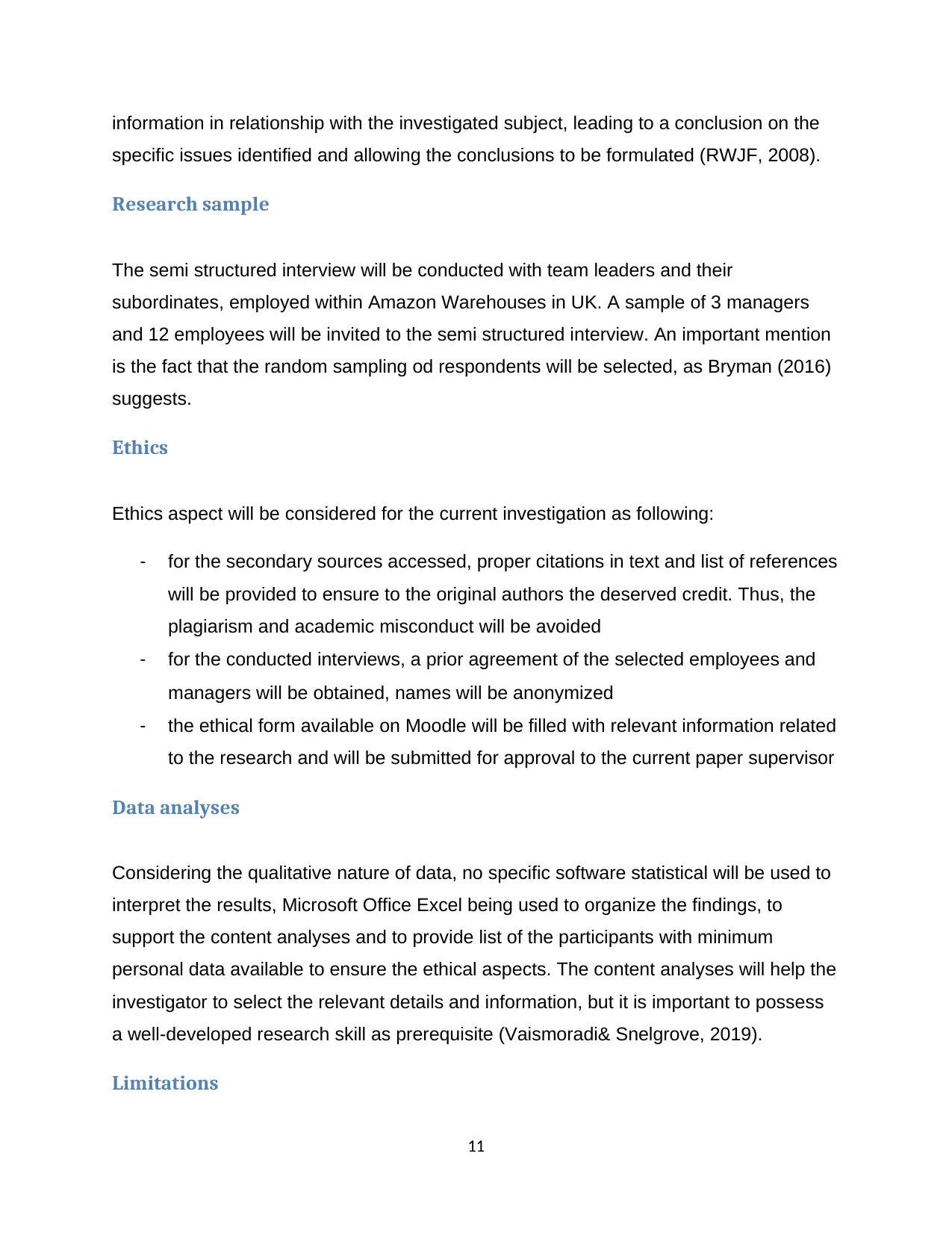
information in relationship with the investigated subject, leading to a conclusion on the
specific issues identified and allowing the conclusions to be formulated (RWJF, 2008).
Research sample
The semi structured interview will be conducted with team leaders and their
subordinates, employed within Amazon Warehouses in UK. A sample of 3 managers
and 12 employees will be invited to the semi structured interview. An important mention
is the fact that the random sampling od respondents will be selected, as Bryman (2016)
suggests.
Ethics
Ethics aspect will be considered for the current investigation as following:
- for the secondary sources accessed, proper citations in text and list of references
will be provided to ensure to the original authors the deserved credit. Thus, the
plagiarism and academic misconduct will be avoided
- for the conducted interviews, a prior agreement of the selected employees and
managers will be obtained, names will be anonymized
- the ethical form available on Moodle will be filled with relevant information related
to the research and will be submitted for approval to the current paper supervisor
Data analyses
Considering the qualitative nature of data, no specific software statistical will be used to
interpret the results, Microsoft Office Excel being used to organize the findings, to
support the content analyses and to provide list of the participants with minimum
personal data available to ensure the ethical aspects. The content analyses will help the
investigator to select the relevant details and information, but it is important to possess
a well-developed research skill as prerequisite (Vaismoradi& Snelgrove, 2019).
Limitations
11
specific issues identified and allowing the conclusions to be formulated (RWJF, 2008).
Research sample
The semi structured interview will be conducted with team leaders and their
subordinates, employed within Amazon Warehouses in UK. A sample of 3 managers
and 12 employees will be invited to the semi structured interview. An important mention
is the fact that the random sampling od respondents will be selected, as Bryman (2016)
suggests.
Ethics
Ethics aspect will be considered for the current investigation as following:
- for the secondary sources accessed, proper citations in text and list of references
will be provided to ensure to the original authors the deserved credit. Thus, the
plagiarism and academic misconduct will be avoided
- for the conducted interviews, a prior agreement of the selected employees and
managers will be obtained, names will be anonymized
- the ethical form available on Moodle will be filled with relevant information related
to the research and will be submitted for approval to the current paper supervisor
Data analyses
Considering the qualitative nature of data, no specific software statistical will be used to
interpret the results, Microsoft Office Excel being used to organize the findings, to
support the content analyses and to provide list of the participants with minimum
personal data available to ensure the ethical aspects. The content analyses will help the
investigator to select the relevant details and information, but it is important to possess
a well-developed research skill as prerequisite (Vaismoradi& Snelgrove, 2019).
Limitations
11
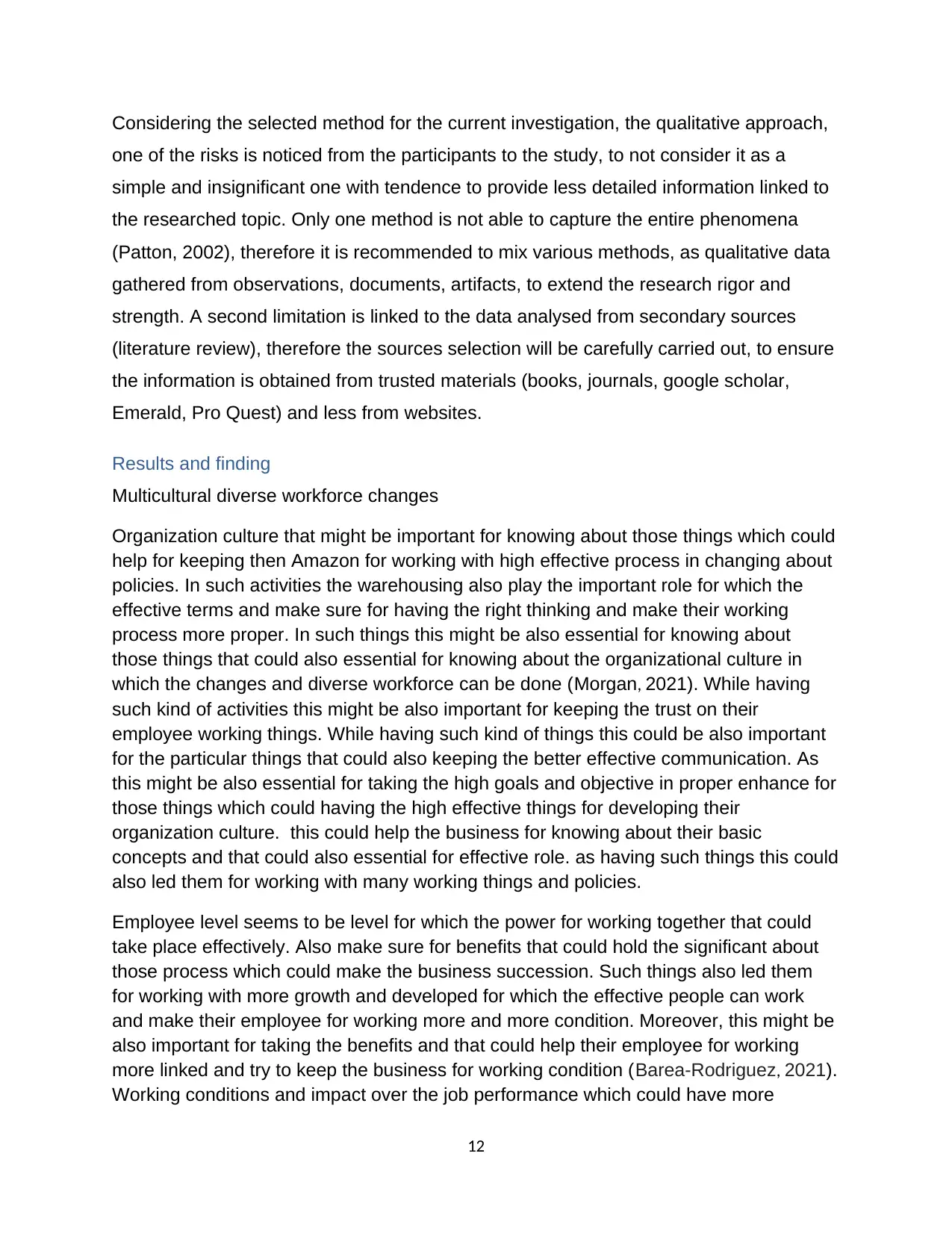
Considering the selected method for the current investigation, the qualitative approach,
one of the risks is noticed from the participants to the study, to not consider it as a
simple and insignificant one with tendence to provide less detailed information linked to
the researched topic. Only one method is not able to capture the entire phenomena
(Patton, 2002), therefore it is recommended to mix various methods, as qualitative data
gathered from observations, documents, artifacts, to extend the research rigor and
strength. A second limitation is linked to the data analysed from secondary sources
(literature review), therefore the sources selection will be carefully carried out, to ensure
the information is obtained from trusted materials (books, journals, google scholar,
Emerald, Pro Quest) and less from websites.
Results and finding
Multicultural diverse workforce changes
Organization culture that might be important for knowing about those things which could
help for keeping then Amazon for working with high effective process in changing about
policies. In such activities the warehousing also play the important role for which the
effective terms and make sure for having the right thinking and make their working
process more proper. In such things this might be also essential for knowing about
those things that could also essential for knowing about the organizational culture in
which the changes and diverse workforce can be done (Morgan, 2021). While having
such kind of activities this might be also important for keeping the trust on their
employee working things. While having such kind of things this could be also important
for the particular things that could also keeping the better effective communication. As
this might be also essential for taking the high goals and objective in proper enhance for
those things which could having the high effective things for developing their
organization culture. this could help the business for knowing about their basic
concepts and that could also essential for effective role. as having such things this could
also led them for working with many working things and policies.
Employee level seems to be level for which the power for working together that could
take place effectively. Also make sure for benefits that could hold the significant about
those process which could make the business succession. Such things also led them
for working with more growth and developed for which the effective people can work
and make their employee for working more and more condition. Moreover, this might be
also important for taking the benefits and that could help their employee for working
more linked and try to keep the business for working condition (Barea-Rodriguez, 2021).
Working conditions and impact over the job performance which could have more
12
one of the risks is noticed from the participants to the study, to not consider it as a
simple and insignificant one with tendence to provide less detailed information linked to
the researched topic. Only one method is not able to capture the entire phenomena
(Patton, 2002), therefore it is recommended to mix various methods, as qualitative data
gathered from observations, documents, artifacts, to extend the research rigor and
strength. A second limitation is linked to the data analysed from secondary sources
(literature review), therefore the sources selection will be carefully carried out, to ensure
the information is obtained from trusted materials (books, journals, google scholar,
Emerald, Pro Quest) and less from websites.
Results and finding
Multicultural diverse workforce changes
Organization culture that might be important for knowing about those things which could
help for keeping then Amazon for working with high effective process in changing about
policies. In such activities the warehousing also play the important role for which the
effective terms and make sure for having the right thinking and make their working
process more proper. In such things this might be also essential for knowing about
those things that could also essential for knowing about the organizational culture in
which the changes and diverse workforce can be done (Morgan, 2021). While having
such kind of activities this might be also important for keeping the trust on their
employee working things. While having such kind of things this could be also important
for the particular things that could also keeping the better effective communication. As
this might be also essential for taking the high goals and objective in proper enhance for
those things which could having the high effective things for developing their
organization culture. this could help the business for knowing about their basic
concepts and that could also essential for effective role. as having such things this could
also led them for working with many working things and policies.
Employee level seems to be level for which the power for working together that could
take place effectively. Also make sure for benefits that could hold the significant about
those process which could make the business succession. Such things also led them
for working with more growth and developed for which the effective people can work
and make their employee for working more and more condition. Moreover, this might be
also important for taking the benefits and that could help their employee for working
more linked and try to keep the business for working condition (Barea-Rodriguez, 2021).
Working conditions and impact over the job performance which could have more
12
⊘ This is a preview!⊘
Do you want full access?
Subscribe today to unlock all pages.

Trusted by 1+ million students worldwide
1 out of 24
Related Documents
Your All-in-One AI-Powered Toolkit for Academic Success.
+13062052269
info@desklib.com
Available 24*7 on WhatsApp / Email
![[object Object]](/_next/static/media/star-bottom.7253800d.svg)
Unlock your academic potential
Copyright © 2020–2025 A2Z Services. All Rights Reserved. Developed and managed by ZUCOL.





